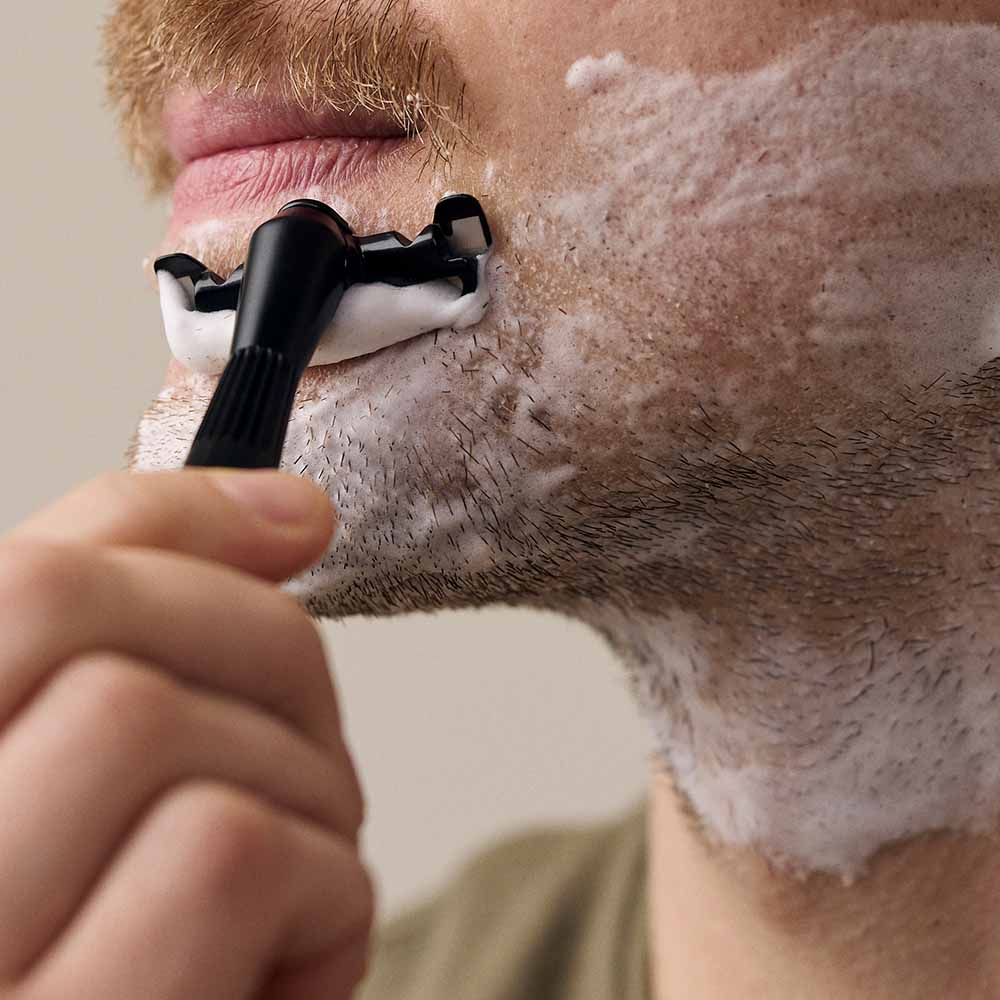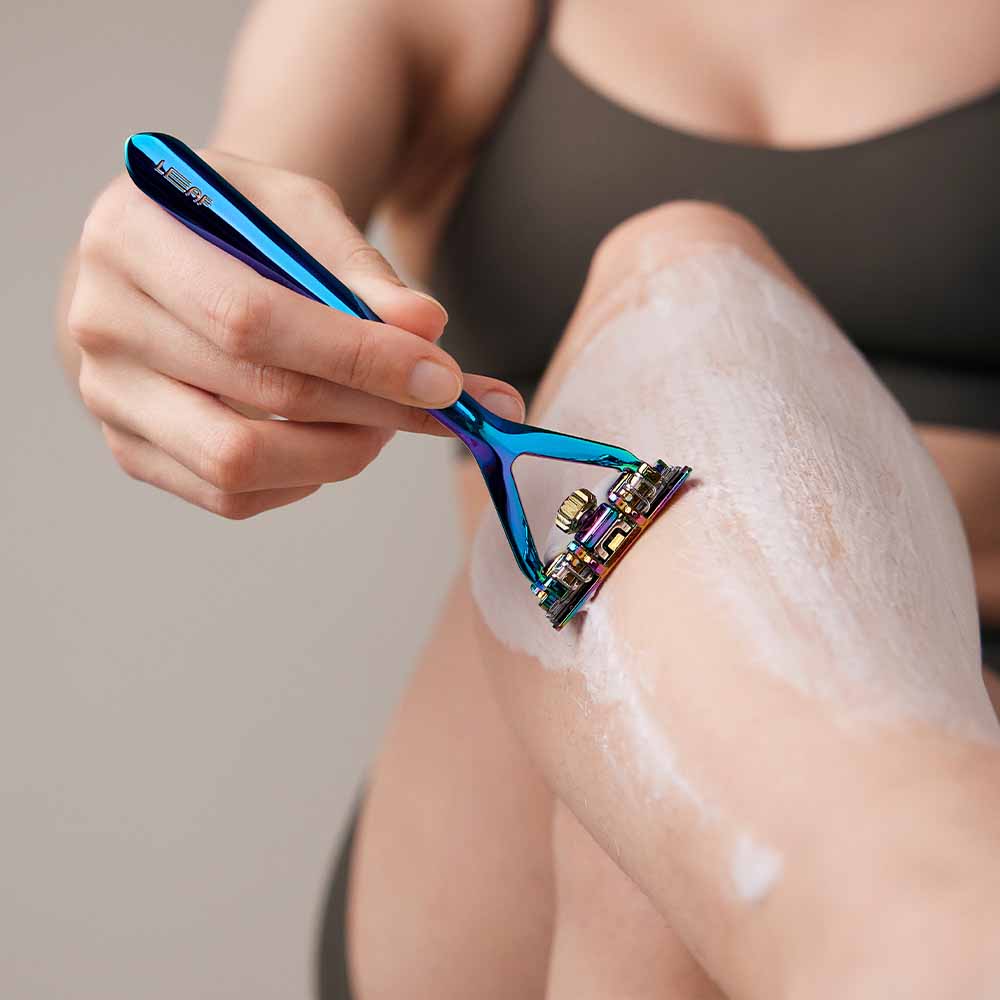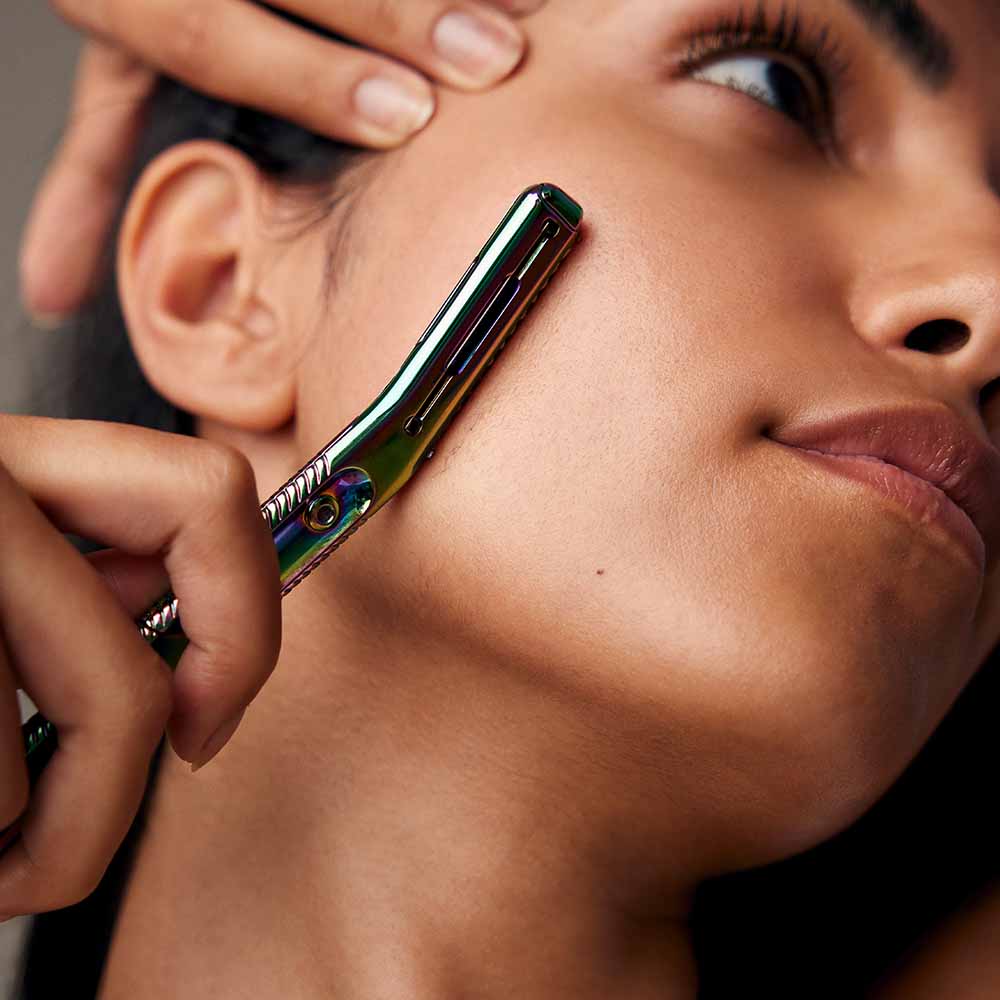GETTING STARTED
Start here and review the below information. Next, watch the videos to see your new tool in action. And if you ever have any questions please reach out to us at support@leafshave.com.
HOW TO USE | LOAD
LOAD YOUR RAZOR:
- Your Twig/Thorn Razor does not come with a blade loaded, you will find a 5 pack of single-edge blades tucked next to the razor inside of it’s box.
- Open the razor by twisting the bottom part of the razor to the right (the direction you would twist a Chapstick to raise the product). The head will rise up and then start turning to one side, exposing the blade layer.
- To “load a blade,” place a blade onto the layer, notching both sides. You may find it useful to hold the blade from one side and notch the opposite side first, then slide the blade into position notching the second side. Watch the videos below for a visual representation of loading.
- The Twig Razor is the mild version of our single-edge model, and the Thorn Razor is the medium version. Mild and medium refer to the relative “aggressiveness” of the shave. A razor’s aggressiveness is a measurement of how much skin-contact is allowed against the blade. The more aggressive the razor, the more skin-contact is allowed, which may lead to a more-efficient shave, or a closer-shave per swipe of the razor along your skin.
- The Thorn Razor has an extra 0.2mm of “blade gap” and “blade span” when compared to the Twig Razor. This is what makes it a medium-level aggressive razor. Thorn Razor is best suited for people with thicker, coarser hair or people looking for a more aggressive razor.
Watch the instructional videos below to see how to load your new razor.
Note: It does not matter which face of the blade is up they work the same either way.
HOW TO USE | PREP
PREPARE YOUR SKIN
- Thoroughly wash and exfoliate your skin prior to shaving. Soften your hair using warm or hot water, and then apply Shave Oil, or Shave Soap (or a combination of the two) to lay down a protective cushion against your skin.
- Understand which direction your hair grows. When you read “with the grain” of hair growth, this means you’re drawing the blade across your skin in the direction that your hair naturally lays down flat. When you read “against the grain” of hair growth, this means you’re drawing the razor in the opposite direction, when your hair feels more prickly because you’re pushing it up against it’s naturally flat-laying position.
HOW TO USE | SHAVE
SHAVING
Lay the razor against your skin at a roughly 45 degree angle, and draw the razor across your skin in short strokes. You should feel the blade engaging with your skin and hair, if you don’t, re-check your angle. If you do not find this angle intuitive, try this:
- Place the head of the razor against your skin, with the razor fully perpendicular (sticking straight out).
- Start rotating the handle towards your skin in the direction you’ll be shaving (closing the angle from 90 degrees to be smaller and smaller).
- When you’re halfway from perpendicular, you’ll feel the blade engage. This is your shave angle.
Depending on your skin and hair, and your desired level of closeness, complete one pass with the grain of hair growth, re-apply Shave Soap, and complete a second pass across-the-grain or against-the-grain of hair growth for the closest finish.
AFTER SHAVING
Rinse your skin clean and finish with a light layer of Calming Serum to help fight off and reduce any irritation that may result from shaving.
CAUTIONS
- Each blade may be used until you feel that it is no longer shaving, this is usually experienced as a tugging feeling from the blade.
- Before using your Twig or Thorn Razor, read through all instructions carefully.
- Exercise caution when handling blades, loading blades, and using the razor. The blades are sharp and may cause injury if not loaded and used properly. You should not use the razor if you are unable to safely load and handle the blades.
- Please keep the razor and blades out of reach of children.
- Do not use the razor unless blades are properly installed. To understand how blades are properly installed, review these instructions and watch the instructional videos below.
- If you have any questions or concerns of any kind, please reach out to support@leafshave.com and discontinue use of your razor until your question(s) are resolved.
- For best long-term life, periodically apply lubrication to the internal screw system of your single-edge razor (for example, 1 or 2 drops of Shave Oil in the underside of the handle, and then work the screw fully open and fully closed while upside down a couple of times to coat the internals). Apply as needed for long-term smooth operation.
Use only as directed.
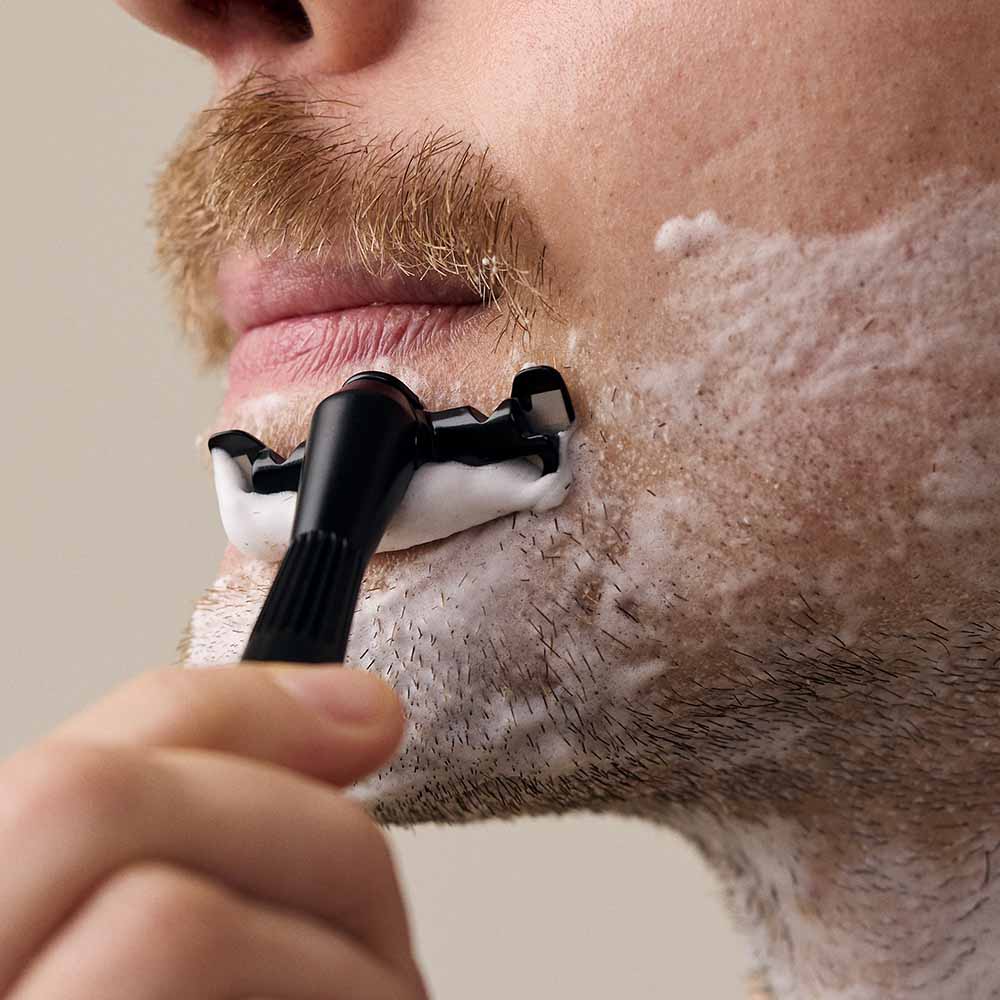
USING YOUR TWIG OR THORN RAZOR
Once you get things set up, it’s time to shave. Welcome to a better way! Your Twig or Thorn razor is designed to be a full replacement for multi-blade cartridges. The single-edge design, paired with a good shave routine, will give you a perfectly smooth shave with less irritation and reducing risk of ingrown hair. Keep these things in mind when using your razor for the first time:
- You may encounter a short learning curve. Some people take to it right away, some need a handful of shaves. The biggest difference is the weight, and the sharpness of the blade.
- You should find the shave-angle very naturally. The blade will engage when the razor is around 45 degree angle against your skin (the handle will be half-way to perpendicular).
- Work in shorter strokes than you might be used to. Apply only as much pressure as needed to comfortably move the blade across your skin.
- Plan for a two (or three-pass) shave as needed. Generally speaking, your first pass should be with the grain-growth of your hair. And if you require a closer shave, re-lather and make a pass across-the-grain or against-the-grain depending on your needs and how comfortable your skin is.
And if you want to see it in action first, watch some of these videos below from real people using their Leaf Razor.
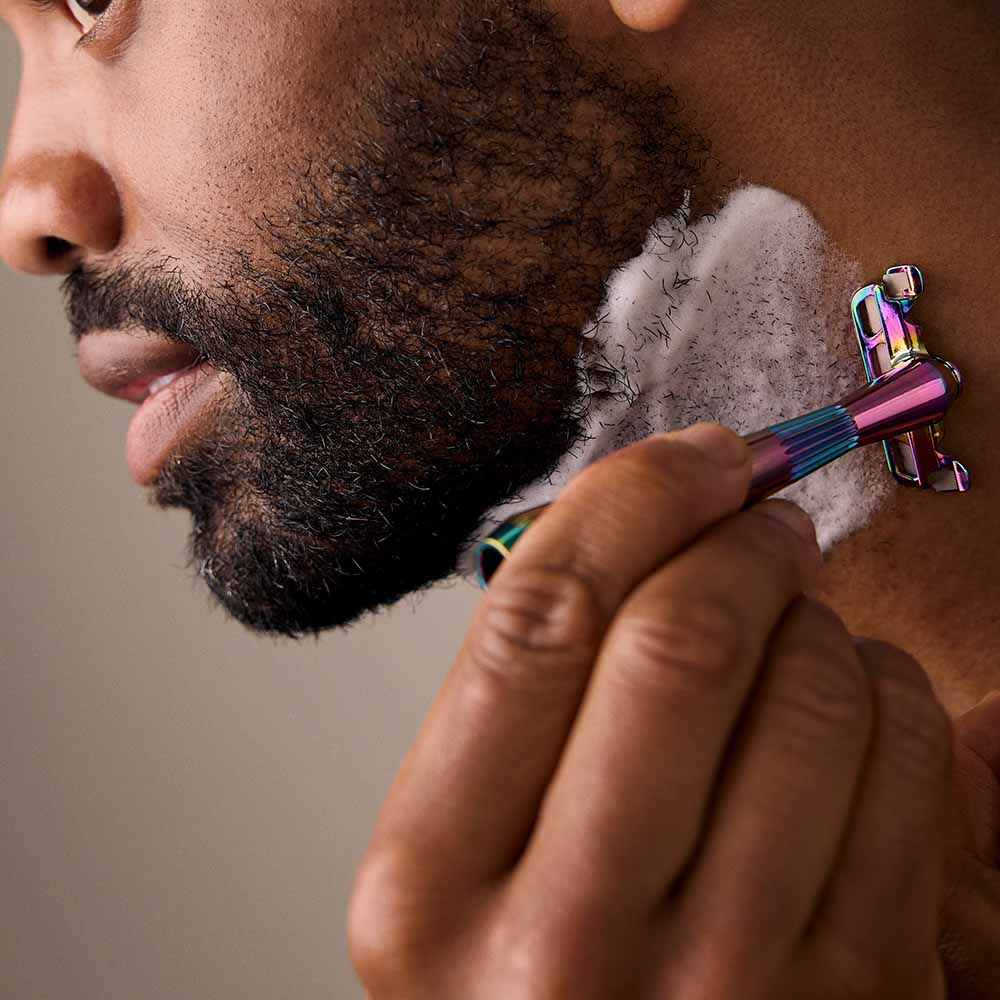
USING A SINGLE-EDGE RAZOR TO ADDRESS RAZOR BUMPS
Razor bumps, also known as pseudofolliculities barbae (or ingrown hair), can be a frustrating result of shaving for many face shavers, particularly in the neck area. It's important to understand that there are some things in your control, and some things (genetics leading to skin or hair types predisposed to ingrown hair) out of your control.
- Pre-Shave Prep: Exfoliate! Clean your skin and clear away dead skin cells. Then warm your skin and hair, softening the follicles.
- Sharp Blades: If you suffer from razor bumps, prioritize swapping in new, fresh and sharp blades more frequently.
- Technique: Ingrowns happen when regrowing hair gets trapped beneath your skin. The most sure-fire way to avoid razor bumps is to avoid shaving so-close that the hair ends up under your skin. Try shaving with-the-grain of hair growth only. You may feel stubble still, but at least you won’t have ingrowns.
- After Care: Rinse your skin, finish with cold-water, and continue to keep your skin exfoliated in the next couple of days.
Fore more information, read through our blog post on how to tackle ingrown hair and razor bumps on your neck.

SHAVING AROUND YOUR BEARD
If you routinely keep facial hair, you still need a way to maintain it and keep it looking and feeling clean. We typically recommend our single-edge razor for shaving and maintaining beards.
Both Twig and Thorn versions make good tools for shaving the cheeks and necklines around a beard.
Tip: Shave Oil doubles as a beard oil. Facial hair can get dry and brittle as it grows out, it’s important to the health and comfort of your beard to keep your hair hydrated. After shaving your cheek and neckline, rub a little Shave Oil into your beard to keep it soft and comfortable.
FAQ
Common getting started questions.
HOW CLOSE OF A SHAVE SHOULD I EXPECT?
All Leaf Shave razors are capable of providing a perfectly close, smooth shave.
Single-edge shaving razors are, by design, optimized to shave hair at the surface of your skin (not below it).
These razors work most effectively, and consequently shave closest, when you do not press hard. Skim the blade across the surface of your skin. And for the closest shave, make an against-the-grain pass (as either your only pass, or your second pass after a with-the-grain pass and re-lathering).
The Thorn Razor version will more-easily shave closer, because it allows more skin contact with the blade than the Twig Razor. This is especially true for thicker, coarser hair.
WILL I NICK MYSELF SHAVING?
While there is always a risk of nicks when shaving with blades and razors, Leaf Shave's Twig and Thorn razors are designed to minimize these issues. The small learning curve when first getting started is primarily in the weight of the razor.
The adjustment to make and to get a feel for is that you do not need to press down hard. Slow down your strokes, make shorter strokes, and skim the razor across your skin letting the weight of the metal do the work for you.
HOW DO I CARE FOR IT?
For best long-term life, periodically apply lubrication to the internal screw system of your single-edge razor (for example, 1 or 2 drops of Shave Oil in the underside of the handle, and then work the screw fully open and fully closed while upside down a couple of times to coat the internals). Apply as needed for long-term smooth operation.
WILL THE RAZOR RUST?
The razor itself won't rust, it's finished to prevent corrosion. However, shaving blades of any variety are made of a type of stainless steel that will eventually oxidize. This process is accelerated by the presence of water. So if you'd like to keep your blades lasting as long as possible, keep them dry between uses.
If you do find that the blade has tarnished and stained the inside of your Twig or Thorn Razor head: don't worry, simply clean it off. Take a dab of dish soap and an old toothbrush and scrub-a-dub-dub the head.
HOW LONG DO THE BLADES LAST?
This varies person-to-person, some people will go months on a set of blades, others prefer to swap the blades every few shaves. How often you shave, how much you're shaving, and how tough your hair is drives a lot of the difference.
You should change your blades when you feel that they're not shaving as well as you'd like. This will feel more like tugging, as the blades are dulling.
We recommend pushing your first few sets of blades as long as you can, so that you get a good feel for how many shaves (or weeks / months) they comfortably last for you.
WHAT'S THE DIFFERENCE BETWEEN TWIG AND THORN RAZOR?
The Twig and Thorn are two versions of the Leaf Shave single-edge razor model. They are otherwise identical, except that the Thorn has an extra:
- 0.2mm of blade gap (space below the blade)
- 0.2mm of blade span (space in front of the blade)
What this means practically is that the Thorn version allows for more skin contact with the blade. This can result in a closer or more efficient razor (some may call it a more aggressive razor) than the Twig version.
We rate the Twig as "mild" and the Thorn as "medium" on a scale of aggressiveness across the available options of safety razors.
Which one is right for you?
If you have lighter hair, the Twig may be a great choice, and if you have darker, coarser hair you may want the extra efficiency of the Thorn. Both razors are capable of providing a smooth, close finish.
HOW TO CARE FOR YOUR RAZOR
Your new Twig or Thorn Razor is a tool that you want to keep around for a long time. With proper care, that will be the case. Don’t feel intimidated by caring for your razor, though, it’s not onerous. Live by this simple rule: keep it at a base level of clean.
CARE DURING AND AFTER USE
DURING
While using the Twig or Thorn razor, rinse the blade-face from the front and back as needed to keep it clear of hair.
AFTER
After finishing with the Twig or Thorn razor, rinse it thoroughly from the outside, or open the head and rinse inside if needed.
Opening and rinsing inside is not necessary but can be helpful after heavy shaves to ensure a clean tool between uses.
LONG-TERM CARE
EVERY NOW AND THEN
If you notice your razor accumulating shave soap or hair residue, periodically scrub it clean. First, remove all the blades. Using an old toothbrush designated for razor cleaning, apply a small amount of dish soap. With water, scrub all over, working up a good bubbly lather. Scrub the front, the back, around the screw crown, and open the head to scrub on top and beneath each layer. Work through all the nooks and crannies until you are satisfied.
Thoroughly rinse off the soap, and use a soft cloth or towel to dry the razor. If desired, you can finish this cleaning with a dunk in rubbing alcohol. Reinstall a fresh set of blades.
DEEP CLEANSE AS NEEDED
For long-term soap residue or rust stains from the blades, prepare a bath of diluted white vinegar (1:1 with water) and soak the razor for no more than 10 minutes. Then, perform the above cleaning process.
APPLY LUBRICATION PERIODICALLY
For best long-term life, periodically apply lubrication to the internal screw system of your single-edge razor (for example, 1 or 2 drops of Shave Oil in the underside of the handle, and then work the screw fully open and fully closed while upside down a couple of times to coat the internals). Apply as needed for long-term smooth operation.
EXPLORE COMMUNITIES
Looking for more context around where you’re shaving? Visit our community pages.




